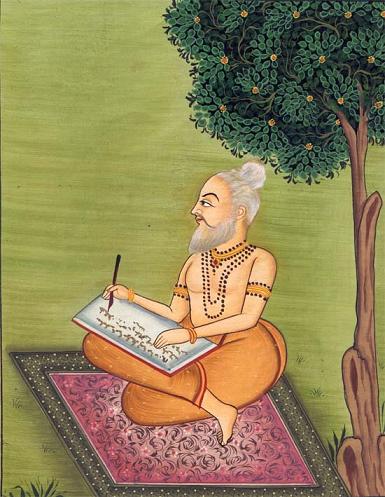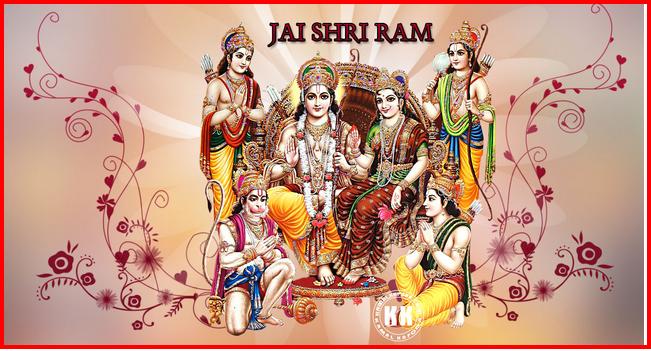Raghu Veera Gadhyam is one of the many brilliant and moving stotrams composed by Sri Vedantha Desikan, while he was residing in Thiruvahindrapuram. At this divya desam, there are the most beautiful Archa murthys of Sri Ramachandra, Sita Devi, and Lakshmana. Swami Desikan was thrilled one day by the incomparable beauty of Sri Ramachandra giving darsanam as Kodhanda Rama at this kshetram and recollections about the extraordinary valour of our Lord and his deeds on the battle field as the Maha Veera at Lanka. Inspired by those thoughts, he summarized in his splendid Gadhyam (work in prose style ) the Vaibhavam of this Maha Veera and named it appropriately Maha Veera Vaibhavam. Later this work came to be known by its popular name of Raghu Veera Gadhyam.
Swami Desikan as a Sarva Tantra Svatantra might also have followed the foot steps of his Paramacharya, Sri Ramanuja, who composed his three master pieces in the Gadhyam form (Sri Vaikunta Gadhyam, Saranagathi Gadhyam and Sriranga Gadhyam). Swami Desikan was so fascinated by the Gadhya Trayas of Sri Ramanuja that he created a commentary on them known as Gadhya Traya Bhashya. This work fits inside another work of Swami Desikan known as Rahasya Raksha with four chapters.

The first chapter of Rahasya Raksha is the commentary on Saranagathi Gadhyam also known as Prthugadhyam. The second chapter is known as Mitagadhya Bhashyam consisting of commentaries on both Sriranga and Vaikunta Gadhyams. The subject matter of Sri Ramanuja’s Gadhyams were the important doctrine of Prapatthi and his supreme devotion to the Archa murthy at Srirangam worshipped by Sri Ramachandra himself(Sriranga Gadhyam ) and the raptourous description of Sri Vaikuntam (Sri Vaikunta Gadhyam), the supreme abode of Sriman Narayana and His consort, the object of our Prapatthi.
It is not an exaggeration to state that Swami Desikan’s Raghu Veera Gadhyam is his OWN Prapatthi to the Lord, who declared at Sethu : ” It is my solemn covenant that I stand by anyone who surrenders his all to my keeping. According to this Vibhishana comes under my protecting hand, which even Ravana is free to accept. I now charge Sugreeva to hail Vibhishana and lead him to me”. It is no wonder that the entire Ramayana is revered as Saranagathi Sastra by Sri Vaishnavas.Infact, Sri Ramunuja himself learned the special meanings of Srimad Ramayanam (Sarangathi ) from Srisailapurna or Thirumalai Nambi, a native of Thiruppathi. Swami Desikan went on to describe the mystry and sacredness of Prapatthi in Sanskrit and Manipravala texts such as Sarangathi Deepikai,Abhayapradanasara, Rahasyatayasara et al.

We are therefore fully justified in considering the delectable Raghu Veera Gadhyam of Swami Desikan as the celebration of the Lord’s covenant to Prapannas housed as the central message of the seven cantos of Srimad Ramayanam. Swami Desikan celebrarted the veeram or Parakramam aspect of Veeraraghavan in this Gadhyam. He went on to celebrate in yet another stotram the valor of this RaNa Pungavan presiding as Archa Murthy at Thriuputkuzhi with the divya namam of Vijaya Ragjhavan. Elsewhere, Thirumangai Azhwar has performed Mangalasaasanam for Veeraraghavan, the Archa Murthy at Thiruvellore Divya Desam.Kulasekhara celebrated the valor of the Lord at Tillai Thiruchitrakootam. Saint Thyagaraja saluted his valor at battle by describing Him as ” Dhanda Chathuran ” in his Kapi-Naarayani song ” Sarasa Saama Dhana Dhanda Chathura Saati Davamevareh ? “.The bard asked ” O Rama! You are adept in statesmanship and in wielding the four expedients, conciliation(sama), winning over with gifts (Dhana),separating the enemies(Bheda) and punishing by war (DHANDA ). Who is there equal to You ?”. The saint invited that Raghuveera affectionately again in his Huseni krithi: ” Raghuveera RaNadheera! Raa Raa, Rajakumara !”
We will seek Swami Desikan’s blessings in enjoying his magnificient Gadhyam on Raghu Veeran.
In this section, we will cover the following items :
1. When to read Srimad Ramayanam& Raghuveera Gadhyam?
2. Where to read Srimad Ramayanam& Raghuveera Gadhyam ?
3. What are the procedures to follow before Reading either ?
4. What are the fruits/benefits of reading either ?
5. How do they compare in size and structure ?
RAAMAAYA RAMABHADRAAYA RAMACHANDRAAYA VEDHASEH |
RAGHUNAATHAAYA NAATHAYA SEETHAAYA: PATAYEH NAMA: ||
( My salutations to Veda Purusha Sri Rama, who is celebrated as Ramachandra, Ramabhadra,Raghunatha and the Lord of Sita Devi )
AAPADHAAM APAHARTHAARAM DHAATHAARAM SARVA SAMPADHAAM |
LOKAABHIRAMAM SRI RAAMAM BHUYOH BHUYOH NAMAAMYAHAM ||
(I salute again and again Sri Rama, the delight of the whole world, the reliever/ banisher of every suffering and the bestower of all riches)
1.WHEN TO READ BOTH ?
The Aadhi Kaavyam (epic poem ) composed by sage Valmiki (Srimad Ramayanam) consisting of seven books (Khaandas) and 645 Cantos (Sargas) is recommended for reading in a nine day stretch (Navaaham ) or in a 27 day stretch. The nine day reading with starts and stops at particular chapters is recommended for the months of Chaitra, Maagha and Kartika during Sukla Paksham (5th day to the the thirteenth day). The 27 day reading is to be carried out starting from the day, when the constellation of Punarvasu is in ascendance to the day, when Aardhraa constellation is in ascendance. There are elaborate procedures for reading Srimad Ramayanam( Sankalpam, Acharya Vandanam, Dhyaanam, Nyaasam (Anganyaasam and Karanyaasam ) and Viniyogam for each of the Khaandams.
The procedures for reciting Swami Desikan’s Raghuveera Gadhyam are few and simple.One can recite it every day. One recites at the beginning and ending of the stotram ” NEELA KOMALA RUCHIM RAAMAM BHAJEH SYAAMALAM “(I meditate on Sri Rama of cerulean hue possessing the soft lustre of the blue lotus ). Next one recites Acharya Dhyanam :
SRIMATHE NIGAMAANTHA MAHA DESIKAAYA NAMA:
SRIMAAN VENKATANAATHAARYA: KAVITHAARKIKA KESARI I
VEDHANTHAACHAARYAVARYOH MEH SANNIDHATTAAM SADHAA HRUDHI II
This is followed by the recitation of the entire Raghuveera Gadhyam.
A the conclusion, one salutes again the composer of this stotram:
KAVITHAARKIKA SIMHAAYA KALYAANA GUNASAALINEH |
SRIMATHEH VENKATESAAYA VEDAANTHAGURAVEH NAMA : ||
Finally, the Mangala slokam for Sri Rama is recited :
MANGALAM KOWSALENDRAAYA MAHANEEYA GUNAATHMANEH |
CHAKRAVARTHI TANUJAAYA SAARVABHOWMAAYA MANGALAM ||
2.WHERE TO READ ?
One can recite both in front of a Salagrama murthy, Tulasi plant or in a temple or at the puja graham of one’s own home. If the recitation is done in front of SaLagramam, One should bathe the Murtham in milk, dry it and then start the recitation. (Sri M.S. Krishnamachar’s monograph released by Visishtaadvaita PrachariNi sabhaa contains enormous details on the types of SaaLagrAmAs. Lakshmi Narasimha, Lakshmi Narayana,Seetha Rama and Lakshmi Hayagreeva SaaLigrAmams are particularly welcome to be used in the PaarayaNam ).
3.PURPOSES OF READING
Those wishing progeny read BalaKhandam ; those who seek wealth read Ayodhyaa Khaandam ; those wanting to secure a friend or wishing to secure back lost wealth read Kishkindhaa Khaandam ; those wishing fulfilment of their desires (Kaamyaarthi ) read Sundara Khaandam; Yuddha Khandam is read by those wishing the destruction of their enemies/obstacles ; Uttara Khaandam is read by those, who wish liberation from the cycles of births and deaths (Moksham ). This is for reading of the individual Khaandams of Valmiki Ramayanam. The reading of Raghuveera Gadhyam confers all of the above blessings on the reciter. Both Srimad Ramayanam and Sri Raghuveera Gadhyam are considered as the unsurpassed form of Gayatri Mantram.
4. A COMPARISON OF SIZES
Srimad Ramayanam has 7 Khaandams; Sri Raghuveera Gadhyam has the summary of 6 Khaandams. Latter does not include Aaranya Khaandam. You might also note that the previous section on “purpose of Reading” omitted Aaranya Khaandam.
Valmiki Ramayanam(VR ) has 645 Cantos (Sargams ) housed in its
six books (Khaandams ); Sri Raghuveera Gadhyam has 92
salutatations in 6 sections. The Book by Book comparison is as follows
with Raghuveera Gadhyam related information in paranthesis :
Bala Khaandam — : VR 77 (18)
Ayodhyaa Khaandam—: VR 119 (21)
Aaranya Khaandam –: VR 75(0)
Kishkindaa Khaandam–: VR 67(5)
Sundara Khaandam—: VR 68(1)
Yuddha Khaandam –: VR 128(29)
Uttara Khaandham–: VR 111(18)
TOTAL CANTOS : VR 645 / (92 WITH THE EXCEPTION OF PRELIMINARY SALUTATON AND CONCLUDING PORTIONS OF RAGHUVEERA GADHYAM).
SRI SITA LAKSHMANA BHARATA SATRUGNA
SAMETHA SRI RAMACHANDRA PARA BRAMANEH NAMA ::
Oppiliappan Koil Varadachari Sadagopan
(To Be continued)…









